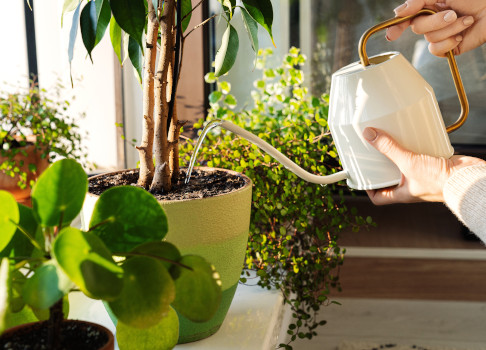Guide to Growing Houseplants
Guide to Growing Houseplants

If you haven’t discovered the joy of houseplants yet, then you’re really missing out. Houseplants are a brilliant way to bring the outdoors in whilst bringing the perfect finishing touch to your home décor. They look fabulous, plus some houseplants actually act as natural air purifiers, cleaning the air from nasty chemicals and converting carbon dioxide to oxygen. It’s also been found that houseplants improve your mood and concentration. How nifty!
Where to grow houseplants
Most houseplants thrive best in plenty of bright but indirect light, so placing them just back from a window is ideal. If you don’t have much natural light in your home, then there are some houseplants that will happily grow in low light such as snake plants, spider plants and dragon trees among others.
Make sure to keep them away from heaters and draughts, as this will decrease humidity and potentially scorch their leaves. This is particularly important in winter when the heating is on much more frequently.


Caring for houseplants - Watering:
When it comes to watering houseplants, this is where most people tend to go wrong, particularly if you are a new houseplant owner. As a rule, it’s best to check the soil by simply sticking your finger in down to about 2 inches. If it feels dry, then it’s probably time for a water. When watering, it’s generally best to give them a generous amount, allowing the water to go right through the pot but it’s important to not let them sit in the water. However, every plant is different so it’s always best to check the requirements for the individual species.
If you’re particularly bad at remembering to water your plants, then succulents or cacti are the best choice for you, as they require much less attention than other houseplants and store water in their leaves, meaning they can go longer without needing a drink.
Caring for houseplants - Humidity:
Most houseplants originally come from tropical areas of the world, so they prefer to be kept warm and humid to replicate their native environment. Misting your plants each day will help keep humidity up, or alternatively you can keep your plants on a tray of damp pebbles.


Caring for houseplants - Cleaning:
Every now and again, your houseplants will require a clean, as dust can settle on the leaves. All you need to do is simply wipe the leaves using a damp cloth to remove the dust. This not only will make your plant look much glossier and healthier but if dust is allowed to build up then this can end up blocking sunlight and pores and stop the plant being able to photosynthesize and breathe.
Feeding
Giving your houseplants a feed can help provide them with the nutrients they need to flourish. Feeding requirements for your houseplant will vary depending on the species.

Feeding - Flowering Plants:
Flowering plants- For flowering houseplants, use a general houseplant fertiliser every 2 weeks in the spring, then as the plant gets closer to flowering, feed it once a week with a potassium rich feed.
Feeding - Foliage Plants:
Foliage plants- Use a high nitrogen fertiliser every 2 weeks for to keep the foliage looking lush and green. Feeding should be reduced in autumn to about once a month then in winter the plants should not require feeding at all.


Feeding - Succulents and Cacti:
These plants will survive quite happily without needing a feed, however if you want your plants to grow and flower more then providing them with a cactus feed will help give them a good boost.





